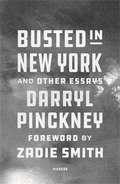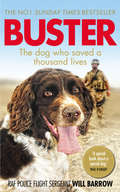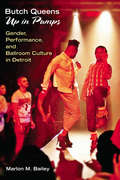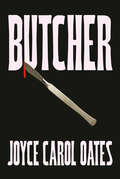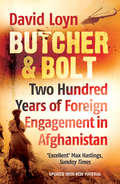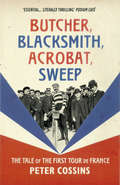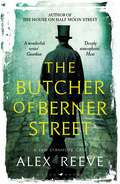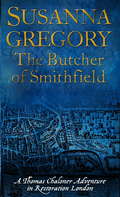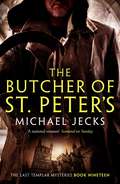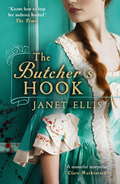- Table View
- List View
Businessman in the Statehouse: Six Years as Governor of North Carolina
by Luther H. HodgesThis is the story of Governor Hodges's years in the statehouse, told in his own words. It is lively, forceful, and honest--like the man himself. It is particularly relevant to the concept that states' rights should be regarded as a challenge to make state government honest, responsible, and forward looking.Originally published in 1962.A UNC Press Enduring Edition -- UNC Press Enduring Editions use the latest in digital technology to make available again books from our distinguished backlist that were previously out of print. These editions are published unaltered from the original, and are presented in affordable paperback formats, bringing readers both historical and cultural value.
Busks, Basques and Brush-Braid: British dressmaking in the 18th and 19th centuries
by Pam InderThe dressmaking trade developed rapidly during the 18th and 19th centuries, changing the lives of thousands of British workers. Busks, Basques and Brush-Braid focuses on the trade and the people within it, from their working conditions and earnings to their training, services and relationships with customers. Exploring the lives of dressmakers in fact and fiction, the book looks at representations of the trade in the plays and novels of the time, while surveying the often harsh realities of the workers' lives. From the arrival of the sewing machine to the influence of the department store, it explores the impact of mechanization, commercialization and modernity on a historical trade. Pamela Inder illuminates a new world of dressmaking enabled by goods like paper patterns and magazines, and sets out to investigate the increasing monopoly of female dressmakers in an industry once dominated by male tailors.Drawing on a range of original and hitherto unpublished sources – including business records, diaries, letters, bills and newspaper articles – Busks, Basques and Brush-Braid reveals the untold story of the dressmaking trade. Beautifully illustrated with over 80 images, the book brings dressmakers into focus as real people, granting new insights into working class life in 18th- and 19th-century Britain.
Busks, Basques and Brush-Braid: British dressmaking in the 18th and 19th centuries
by Pam InderThe dressmaking trade developed rapidly during the 18th and 19th centuries, changing the lives of thousands of British workers. Busks, Basques and Brush-Braid focuses on the trade and the people within it, from their working conditions and earnings to their training, services and relationships with customers. Exploring the lives of dressmakers in fact and fiction, the book looks at representations of the trade in the plays and novels of the time, while surveying the often harsh realities of the workers' lives. From the arrival of the sewing machine to the influence of the department store, it explores the impact of mechanization, commercialization and modernity on a historical trade. Pamela Inder illuminates a new world of dressmaking enabled by goods like paper patterns and magazines, and sets out to investigate the increasing monopoly of female dressmakers in an industry once dominated by male tailors.Drawing on a range of original and hitherto unpublished sources – including business records, diaries, letters, bills and newspaper articles – Busks, Basques and Brush-Braid reveals the untold story of the dressmaking trade. Beautifully illustrated with over 80 images, the book brings dressmakers into focus as real people, granting new insights into working class life in 18th- and 19th-century Britain.
Bussaco 1810: Wellington defeats Napoleon's Marshals (Campaign #97)
by René Chartrand Patrice CourcelleBy 1810, Napoleon reigned supreme over most of continental Europe. But the Iberian Peninsula remained unsubdued, particularly Portugal, which continued to resist. Napoleon ordered Marshal Masséna to crush this resistance with the Army of Portugal. Greatly strengthened, Masséna's army would drive the Portuguese and British into the sea. Facing the French were 60,000 British and Portuguese troops. No-one knew how the Portuguese would perform in battle, but on 27 September 1810, they received their baptism of fire. This title details the gruelling Bussaco campaign as French attempts to subdue Portugal reached their climax.
Bussaco 1810: Wellington defeats Napoleon's Marshals (Campaign #97)
by René Chartrand Patrice CourcelleBy 1810, Napoleon reigned supreme over most of continental Europe. But the Iberian Peninsula remained unsubdued, particularly Portugal, which continued to resist. Napoleon ordered Marshal Masséna to crush this resistance with the Army of Portugal. Greatly strengthened, Masséna's army would drive the Portuguese and British into the sea. Facing the French were 60,000 British and Portuguese troops. No-one knew how the Portuguese would perform in battle, but on 27 September 1810, they received their baptism of fire. This title details the gruelling Bussaco campaign as French attempts to subdue Portugal reached their climax.
Bust: How the Courts Have Exposed the Rotten Heart of the Irish Economy
by Dearbhail McDonaldWhen, after fifteen years of runaway growth based largely on property speculation, the Irish economy finally crashed, Ireland's bankers and developers tried to keep themselves out of sight. But they couldn't keep themselves out of court - and it is in the courtrooms that the full, sickening drama of the Irish meltdown is being played out. Dearbhail McDonald, the brilliant legal editor of the Irish Independent, has been following the high-stakes rows through the courts and, drawing upon her unmatched contacts, tells the often bizarre stories behind an extraordinary reversal of fortune. From the man who ran a pyramid scheme in a Dublin suburb to the leading developer whose business now lies in ruins, from the judges to the solicitors to the ordinary mortgage-holders who find themselves on the wrong side of the law, Bust paints a gripping picture of the human drama - and the human cost - of an economic catastrophe.
Busted in New York & Other Essays: with an introduction by Zadie Smith
by Darryl Pinckney'[Pinckney] reveals himself to be a skilful chronicler of black experience in literary criticism, reportage and biography' The New York Times In these twenty-five essays, Darryl Pinckney has given us a view of our recent racial history that blends the social and the personal and wonders how we arrived at our current moment. Pinckney reminds us that "white supremacy isn't back; it never went away." It is this impulse to see historically that is at the core of Busted in New York and Other Essays, which traces the lineage of black intellectual history from Booker T. Washington through the Harlem Renaissance, to the Black Panther Party and the turbulent sixties, to today's Afro-pessimists, and celebrated and neglected thinkers in between.These are capacious essays whose topics range from the grassroots of protest in Ferguson, Missouri, to the eighteenth-century Guadeloupian composer Joseph Bologne, from an unsparing portrait of Louis Farrakhan to the enduring legacy of James Baldwin, the unexpected story of Black people experiencing Russia, Barry Jenkins's Moonlight, and the painter Kara Walker. The essays themselves are a kind of record, many of them written in real-time, as Pinckney witnesses the Million Man March, feels and experiences the highs and lows of Obama's first presidential campaign, explores the literary Black diaspora, and reflects on the surprising and severe lesson he learned firsthand about the changing urban fabric of New York.As Zadie Smith writes in her introduction to the book: "How lucky we are to have Darryl Pinckney who, without rancor, without insult, has, all these years, been taking down our various songs, examining them with love and care, and bringing them back from the past, like a Sankofa bird, for our present examination. These days Sankofas like Darryl are rare. Treasure him!
Buster: The dog who saved a thousand lives
by RAF Police Sergeant Will Barrow Isabel GeorgeThe Sunday Times Top Ten BestsellerThousands of lives have been saved by this spaniel. He is a best friend in dog’s clothing. An RAF dog with his mossy feet firmly on the ground. A brave dog who has served his colleagues and his country with unstinting devotion. A dog in a million.This is the story of the partnership of Buster and Will, told by Will himself, describing how each came to save the other’s life. This is a relationship that produced some heroic feats in the dust and desert heat of Afghanistan - and beyond. Buster, uniquely, has served five tours of duty - more than any other military dog. “With some dogs you share a boil in the bag breakfast and maybe a blanket on a cold desert floor. Some you wouldn’t leave in charge of your Grandma unless you wanted to find out just how fast the old girl could run. But, if you’re very, very lucky there will be the one dog you would lay down your life for – and for me that dog is Buster.”As told to Isabel George.
'Buster' Crabb: Ian Fleming’s Favourite Spy, The Inspiration for James Bond
by Don HaleCommander Lioinel 'Buster' Crabb was Ian Fleming's inspiration for James Bond. A British naval frogman, Crabb disappeared under mysterious circumstances in 1957 following a secret dive beneath a Russian warship which brought Soviet leaders Khrushchev and Bulganin to Britain. Fifty years after the event, award-winning investigative journalist Don Hale uncovers who sanctioned Crabb's final dive in a case which claimed the jobs of Admiralty top brass and Intelligence people and contributed to the downfall of Prime Minister Anthony Eden.
Busty, Slag and Nob End
by Russell AshBuilding on the phenomenal success of POTTY, FARTWELL AND KNOB, this new collection of extraordinary but true names goes a step further...In BUSTY, SLAG AND NOB END, Russell Ash has compiled real names from around the world that are really rude and are of places and products as well as people. The result of painstaking research, each name has been thoroughly checked and authenticated: you will marvel at the range of naughty nomenclature and hoot at the unwitting innuendo. From Harriet Nicewonger (born Derbyshire c.1876) and Connie Lingus (resident of Indiana, USA) to Dick Swinger (born Switzerland c.1842) and Blo Job (US immigrant from Slovakia, born c.1897); from Titty Ho in Northamptonshire to Dildo in Newfoundland; and from Cock Soup to Pee Cola - this compendium of sauciness is guaranteed to make you laugh out loud.
But You Did Not Come Back
by Marceline Loridan-IvensMarceline Loridan-Ivens was just fifteen when she was arrested by the Vichy government's militia, along with her father. He prepared her for the worst, telling her that he would not return. They were soon separated. The three kilometres between her father in Auschwitz and herself in Birkenau were an insurmountable distance, and yet he managed to send her a small note via an electrician in the camp - a sign of life.In But You Did Not Come Back, Marceline writes a letter to the father she would never know as an adult, to the man whose death enveloped her whole life. Her testimony is a haunting and challenging reminder of one of the worst crimes humanity has ever seen, and an affecting personal story of a woman whose life was shattered and never totally rebuilt.
Butch Queens Up in Pumps: Gender, Performance, and Ballroom Culture in Detroit (Triangulations: Lesbian/Gay/Queer Theater/Drama/Performance)
by Marlon M BaileyButch Queens Up in Pumpsexamines Ballroom culture, in which inner-city LGBT individuals dress, dance, and vogue to compete for prizes and trophies. Participants are affiliated with a house, an alternative family structure typically named after haute couture designers and providing support to this diverse community. Marlon M. Bailey’s rich first-person performance ethnography of the Ballroom scene in Detroit examines Ballroom as a queer cultural formation that upsets dominant notions of gender, sexuality, kinship, and community.
Butcher
by null Joyce Carol OatesFrom one of our most accomplished storytellers, an extraordinary and arresting novel about a women’s asylum in the nineteenth century, and a terrifying doctor who wants to change the world. In this harrowing story based on authentic historical documents, we follow the career of Dr. Silas Weir, “Father of Gyno-Psychiatry,” as he ascends from professional anonymity to national renown. Humiliated by a procedure gone terribly wrong, Weir is forced to take a position at the New Jersey Asylum for Female Lunatics, where he reigns. There, he is allowed to continue his practice, unchecked for decades, making a name for himself by focusing on women who have been neglected by the state—women he subjects to the most grotesque modes of experimentation. As he begins to establish himself as a pioneer of nineteenth-century surgery, Weir’s ambition is fueled by his obsessive fascination with a young Irish indentured servant named Brigit, who becomes not only Weir’s primary experimental subject, but also the agent of his destruction. Narrated by Silas Weir’s eldest son, who has repudiated his father’s brutal legacy, Butcher is a unique blend of fiction and fact, a nightmare voyage through the darkest regions of the American psyche conjoined, in its startling conclusion, with unexpected romance. Once again, Joyce Carol Oates has written a spellbinding novel confirming her position as one of our celebrated American visionaries of the imagination. ‘Simply the most consistently inventive, brilliant, curious and creative writer going, as far as I’m concerned’ Gillian Flynn, author of Gone Girl 'A master storyteller' The Times
Butcher and Bolt: Two Hundred Years Of Foreign Failure In Afghanistan
by David LoynAfghanistan has been a strategic prize for more than 200 years. Foreign invaders have continually fought across its beautiful and inhospitable terrain, in conflicts variously ruthless, misguided and bloody. A century ago, the common sneer about how British soldiers treated Afghan tribesmen was that they would 'butcher' them, then 'bolt'. Butcher and Bolt recounts this violent history, beginning with the very first British mission - an encounter that ushered in two centuries of conflict littered with misunderstandings and broken promises, in which the British, the Russians and later the Americans repeatedly underestimated the ability of the Afghans and the power of the Frontier tribes. In a new final chapter that brings the book right up to date, David Loyn draws on the unique access he has had to Afghanistan over the past two decades to address the emerging threat of the Pakistani Taliban and the challenges that face those now fighting on the most dangerous frontier in the world.
Butcher, Baker, Candlestick Maker: Surviving the Great Fire of London
by Hazel ForsythHazel Forsyth delvesin to never-before-studied primary sources to shed light on thedramatic aftermath of the disaster and reveal the very personalstories of the people who pieced their lives together in its wake. Bydocumenting the tradesmen, from apothecaries and chandlers toshoemakers and watchmakers, Butcher, Baker, Candlestick Makertells a story of loss and resilience and illuminates how the citywe know today rose from the ashes. Beautifully illustrated withexquisite fabrics, candle snuffers and other fascinating imagesassociated with the trades of the time, we are treated to a visualfeast, an evocative reminder of life before and after the Great Fire.
The Butcher Bird: Oswald de Lacy Book 2 (Oswald de Lacy #2)
by S D SykesBook 2 in the gripping Oswald de Lacy series, , which can be read as a standalone, from 'the medieval CJ Sansom' (Jeffery Deaver)The Black Death killed his father and brothers , making Oswald de Lacy Lord of Somershill Manor. It also killed many of his villagers, leaving fewer people to do more work.So Oswald tries to use logic and patience to manage a struggling estate, a socially ambitious mother, an overbearing sister and a mutinous workforce.Then a baby is found impaled on a thorn bush and people say they have seen a huge creature in the skies. The Butcher Bird.And now there is no room for common sense, no time for patience. If Oswald is to survive, he must find the truth behind a series of ever more brutal events.From the plague-ruined villages of Kent to the luxurious bedchambers of London, it is a journey full of danger, darkness and shocking revelations.'The whodunnit aspect is neatly done, the family secrets and waspish relationships are intriguing, and humour and originality are abundant' Daily Mail
Butcher, Blacksmith, Acrobat, Sweep: The Tale of the First Tour de France
by Peter CossinsThe first Tour de France in 1903 was a colourful affair full of adventure, mishaps and audacious attempts at cheating. Its riders included characters like Maurice Garin, an Italian-born Frenchman, said to have been swapped for a round of cheese by his parents in order to smuggle him into France to clean chimneys as a teenager, Hippolyte Aucouturier with his trademark handlebar moustache, and amateurs like Jean Dargassies, a blacksmith who had never raced before. Would this ramshackle pack of cyclists draw crowds to throng France's rutted roads and cheer the first Tour heroes? Surprisingly it did, and, all thanks to a marketing ruse dreamed up to revive struggling newspaper L'Auto, cycling would never be the same again. Peter Cossins takes us through the inaugural Tour de France, painting a nuanced portrait of France in the early 1900s, to see where the greatest sporting event of all began.
The Butcher of Berner Street
by Alex ReeveThe latest atmospheric mystery from the author of the Richard and the Judy Book Club choice, The House on Half Moon Street. The headlines scream warnings about the 'Butcher of Berner Street!' and the journalist behind them – Leo Stanhope – is secretly thrilled to see the effect his words are having. Leo's previous work has largely been concentrated on more mundane issues but when an anonymous letter summons him to a club in East London, only for the owner of the club to be found murdered shortly afterwards, Leo sees a story worth pursuing. Not to mention an opportunity to make a name for himself. Yet the more Leo digs, the stranger the story becomes, taking him from the club to a nearby convent, and into the past of a very unusual woman. But he is not the only one hunting for a killer. And it seems Leo's newspaper reports may have put someone else in grave danger… Praise for the Leo Stanhope series 'Reeve has not only crafted a brilliant crime novel, but has created a character who has made me see the world with new eyes' i'Exceptional – you hear and smell and taste Victorian London' Sarah Hilary 'A deeply atmospheric thriller with more twists and turns than the grubby streets of London, and a central character we really care about' Heat
The Butcher Of Smithfield: 3 (Adventures of Thomas Chaloner #3)
by Susanna GregoryThe third adventure in the Thomas Chaloner series.Having just returned from a clandestine excursion to Spain and Portugal on behalf of the Queen, Thomas Chaloner finds London dank and grey under leaden skies. He finds many things changed, including the Government slapping a tax on printed newspapers. Handwritten news reports escape the duty, and the rivalry between the producers of the two conduits of news is the talk of the coffee houses with the battle to be first with any sort of intelligence escalating into violent rivalry. And it seems that a number of citizens who have eaten cucumbers have come to untimely deaths. It is such a death which Chaloner is despatched to investigate; that of a lawyer with links to 'the Butcher of Smithfield', a shady trader surrounded by a fearsome gang of thugs who terrorise the streets well beyond the confines of Smithfield market. Chaloner doesn't believe that either this death or the others are caused by a simple vegetable, but to prove his theory he has to untangle the devious means of how news is gathered and he has to put his personal safety aside as he tries to penetrate the rumour mill surrounding the Butcher of Smithfield and discover his real identity.'Pungent with historical detail' (Irish Times)'A richly imagined world of colourful medieval society and irresistible monkish sleuthing' (Good Book Guide) 'Corpses a-plenty, exciting action sequences and a satisfying ending' (Mystery People)
The Butcher of St Peter's: Danger and intrigue in medieval Britain (A\medieval West Country Mystery Ser. #Bk. 19)
by Michael JecksA dangerous killer stalks the streets of Exeter... can Sir Baldwin and Simon Puttock hope to catch him? The Butcher of St Peter's is the gripping nineteenth novel in Michael Jecks' popular medieval series, the Knights Templar mysteries, featuring Sir Baldwin de Furnshill and Simon Puttock. Perfect for fans of Ellis Peters and George R. R. Martin.'Compellingly brought to life' - Julian StockwinExeter, 1323: a strange figure - obsessed with children - seems intent on entering people's homes at night. Though many believe him to be harmless, a man now lies dead, slaughtered for protecting his family, and the person responsible must be caught.To Sir Baldwin de Furnshill, the death is suspicious, for the victim had many enemies amid the city's criminal underworld. As the country prepares for yet another civil war, Baldwin faces an impossible task. And when two further bodies are uncovered, the city shudders at the prospect of a killer still at large... What readers are saying about The Butcher of St Peter's: 'A vivid account of life in Medieval Devonshire... I found myself very involved in the story and ended up reading it in one day because I was so fascinated by the scenes and the people''[A] very clever and masterful bit of writing''Michael Jecks never disappoints, his tales keep you guessing right to the end'
The Butcher, the Baker, the Candlestick-Maker: The story of Britain through its census, since 1801
by Roger HutchinsonAt the beginning of each decade for 200 years the national census has presented a self-portrait of the British Isles.The census has surveyed Britain from the Napoleonic wars to the age of the internet, through the agricultural and industrial revolutions, possession of the biggest empire on earth and the devastation of the 20th century's two world wars.In The Butcher, the Baker, the Candlestick Maker, Roger Hutchinson looks at every census between the first in 1801 and the latest in 2011. He uses this much-loved resource of family historians to paint a vivid picture of a society experiencing unprecedented changes.Hutchinson explores the controversial creation of the British census. He follows its development from a head-count of the population conducted by clerks with quill pens, to a computerised survey which is designed to discover 'the address, place of birth, religion, marital status, ability to speak English and self-perceived national identity of every twenty-seven-year-old Welsh-speaking Sikh metalworker living in Swansea'.All human life is here, from prime ministers to peasants and paupers, from Irish rebels to English patriots, from the last native speakers of Cornish to the first professional footballers, from communities of prostitutes to individuals called 'abecedarians' who made a living from teaching the alphabet.The Butcher, the Baker, the Candlestick Maker is as original and unique as those people and their islands on the cutting edge of Europe.
The Butchering Art: Joseph Lister’s Quest to Transform the Grisly World of Victorian Medicine
by Lindsey FitzharrisDAILY MAIL, GUARDIAN AND OBSERVER BOOKS OF THE YEAR 2017Winner of the 2018 PEN/E.O. Wilson Prize for Literary Science WritingShortlisted for the 2018 Wellcome Book Prize and the 2018 Wolfson History PrizeThe story of a visionary British surgeon whose quest to unite science and medicine delivered us into the modern world - the safest time to be alive in human historyIn The Butchering Art, historian Lindsey Fitzharris recreates a critical turning point in the history of medicine, when Joseph Lister transformed surgery from a brutal, harrowing practice to the safe, vaunted profession we know today. Victorian operating theatres were known as 'gateways of death', Fitzharris reminds us, since half of those who underwent surgery didn't survive the experience. This was an era when a broken leg could lead to amputation, when surgeons often lacked university degrees, and were still known to ransack cemeteries to find cadavers. While the discovery of anaesthesia somewhat lessened the misery for patients, ironically it led to more deaths, as surgeons took greater risks. In squalid, overcrowded hospitals, doctors remained baffled by the persistent infections that kept mortality rates stubbornly high. At a time when surgery couldn't have been more dangerous, an unlikely figure stepped forward: Joseph Lister, a young, melancholy Quaker surgeon. By making the audacious claim that germs were the source of all infection - and could be treated with antiseptics - he changed the history of medicine forever. With a novelist's eye for detail, Fitzharris brilliantly conjures up the grisly world of Victorian surgery, revealing how one of Britain's greatest medical minds finally brought centuries of savagery, sawing and gangrene to an end.'A brilliant and gripping account of the almost unimaginable horrors of surgery and post-operative infection before Joseph Lister transformed it all' Henry Marsh, author of Do No Harm
The Butchers: Shortlisted for the 2021 RSL Ondaatje Prize
by Ruth Gilligan'I binged it like a Netflix show... It's stunning' Luke Kennard, author of The Transition______________________________A photograph is hung on a gallery wall for the very first time since it was taken two decades before. It shows a slaughter house in rural Ireland, a painting of the Virgin Mary on the wall, a meat hook suspended from the ceiling - and, from its sharp point, the lifeless body of a man hanging by his feet. The story of who he is and how he got there casts back into Irish folklore, of widows cursing the land and of the men who slaughter its cattle by hand. But modern Ireland is distrustful of ancient traditions, and as the BSE crisis in England presents get-rich opportunities in Ireland, few care about The Butchers, the eight men who roam the country, slaughtering the cows of those who still have faith in the old ways. Few care, that is, except for Fionn, the husband of a dying woman who still believes; their son Davey, who has fallen in love with the youngest of the Butchers; Gra, the lonely wife of one of the eight; and her 12-year-old daughter, Una, a girl who will grow up to carry a knife like her father, and who will be the one finally to avenge the man in the photograph.
The Butcher's Hook: Longlisted for the Desmond Elliott Prize 2016
by Janet Ellis***LONGLISTED FOR THE DESMOND ELLIOTT PRIZE 2016***'KNOWS HOW TO KEEP HER AUDIENCE HOOKED' The Times'A MASTERFUL STORYTELLER' Clare Mackintosh'DARK, WEIRD AND GLORIOUSLY FEMINIST' ElleGeorgian London, in the summer of 1763.At nineteen, Anne Jaccob, the elder daughter of well-to-do parents, meets Fub the butcher's apprentice and is awakened to the possibilities of joy and passion. Anne lives a sheltered life: her home is a miserable place and her parents have already chosen a more suitable husband for her than Fub. But Anne is an unusual young woman and is determined to pursue her own happiness in her own way......even if that means getting a little blood on her hands.'A SHARP EYE AND A SHARPER WIT' Guardian'A SPIRITED, DARK DEBUT' Woman & Home'STRANGE, DARK AND UTTERLY MESMERIC' Hannah KentPre-order Janet Ellis's new novel, How It Was, now!
Buthelezi: A Biography
by Ben TemkinBen Temkin, Buthelezi's biographer, had the full co-operation of Chief Buthelezi in the writing of this book. There were interviews and discussions in KwaZulu and in Johannesburg, in offices, at the airport, in hotels, in private homes and even while they travelled between centres in KwaZulu.




